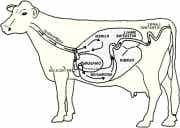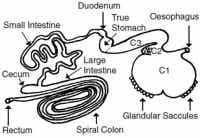RUMINANTS AND CAMELIDS DIGESTIVE OVERVIEW AND FORAGE FEEDING INSTRUCTIONS
Dr. Stephen Duren, Performance Horse Nutrition

Ruminants and camelids are a group of animals that have stomachs with multiple compartments. Ruminants have four compartments to their stomachs while the camelids have three compartments. Examples of ruminant animals include cattle, sheep, goats, buffalo and deer. Camelids include llamas, alpacas and camels.
This multi-compartment stomach approach to digestion allows these animals to digest and utilize plant fiber. Actually, it is the extensive microbial population (bacteria, protozoa and fungi) found in the stomach compartments of these animals that ferment plant fiber into useful end-products the animal can then absorb and utilize. The digestive process is further enhanced with the ability of these animals to regurgitate partially fermented food, often referred to as their cud, and re-chew it for further fermentation. By contrast, horses have a simple, one compartment stomach and a complex hindgut dedicated to fiber digestion.
Digestion in the Ruminant
A ruminant animal has four compartments to the stomach. These compartments include the rumen, reticulum, omasum and abomasum. The rumen is the largest of four compartments and is divided into several sacs. It can hold 25 gallons or more of material, depending on the size of the animal. Because of its size, the rumen acts as storage or a holding vat for feedstuffs. It is also the primary fermentation vat. Simple and complex carbohydrates (fiber) are digested by rumen microbes and converted into volatile fatty acids. The volatile fatty acids (VFA), which consist mainly of acetic, propionic, and butyric acids, are the primary energy source for ruminants. Changing the ratio of forage to grain being fed will change the ratio of VFA produced in the rumen. Approximately 30 to 50 percent of the cellulose and hemicellulose is digested in the rumen by the microbial population. Sixty percent or more of the starch is degraded, depending on the amount fed and how fast ingested materials move through the rumen. Most sugars are 100 percent digested within the rumen. The VFA are absorbed from the rumen into the blood stream and transported to body tissues. The cow derives 50 to 70 percent of its energy from the VFA produced in the rumen. This underscores how important fiber is for a ruminant animal.
Forages that are fed to ruminant animals provide an important source of protein. Protein in forages undergoes fermentation in the rumen. It is converted to ammonia, organic acids, amino acids, and other products. Approximately 40 to 75 percent of the natural protein in feedstuffs is broken down. Proteins that escape breakdown in the rumen, along with microbial protein produced in the rumen, pass to the abomasum and small intestine for digestion and absorption.
The next compartment is a pouch-like structure called the reticulum. The tissues of the reticulum are arranged in a network resembling a honeycomb. Heavy or dense feed and metal objects are caught in the reticulum. A small fold of tissue lies between the reticulum and the rumen, giving it the distinction of being a separate compartment. The third compartment is the omasum. This globe-shaped structure contains leaves of tissue (like pages in a book). The omasum absorbs water and other substances from digestive contents. Feed material between the leaves will be drier than that found in the other compartments. The fourth and final compartment of the ruminant stomach is the abomasum (also called the true stomach). This is the only compartment with a glandular lining. Hydrochloric acid and digestive enzymes, needed for the breakdown of feeds, are secreted into the abomasum. The abomasum is comparable to the stomach of the non-ruminant.
Digestion in the Camelid

Camelids are modified ruminants or “pseudoruminants.” Like ruminants, they use foregut fermentation to break down cellulose in fibrous plant species. But in contrast to ruminants, their forestomaches are made up of three compartments rather than the true ruminants’ (sheep, goats, cattle, deer) four. The three sections of a camelid forestomach are called C-1, C-2 and C-3; each compartment has a specialized job to perform.
C-1, located on the animals left side, is the largest (and first) compartment; it makes up roughly 80% of the stomach’s total volume. C-1 secretes no digestive enzymes – it’s essentially a fermentation vat housing a horde of friendly microorganisms that convert cellulose into digestible nutrients. Llamas specifically are able to sustain nutrient maintenance on low protein diets because of their ability to secrete urea from blood into the rumen to synthesize protein.
Ingested material stays in C-1 for roughly sixty hours, where it is continually mixed by strong, rhythmic contractions of the forestomach. The material next moves into C-2, where some nutrient absorption occurs. Following initial ingestion, Camelids have rhythmic contractions that occur in C-1 and C-2, then eructation (belching) and regurgitation to allow for final digestion. Food material then passes into a tubular organ running along-side C1 on the right side of the abdomen called C-3. It holds 11% of the forestomach volume. The last one fifth of this tube contains true gastric glands,so C-3 is sometimes called the true stomach.Of the camelids, stressed alpacas frequently develop ulcers in C-3, similar to horses. 1
SUMMARY
Ruminants and camelids dedicate the majority of their digestive capacity to fermentation of plant fiber. Thus, forage (plant fiber) is the most important dietary ingredient for these animals. High quality forages, like those grown by Standlee Premium Products, are the bedrock for giving these animals a source of highly fermentable fiber to derive nutrients. In addition, the fiber in the Standlee products keeps the digestive system of these animals healthy.
Feeding Instructions for Forage Products
| Animal Target | Feeding Rate | Forage Formats | Time Frame |
|---|---|---|---|
| Alpaca | 2.00% | Bale, Pellets, Chopped | 14 Days |
| Bison | 2.25% Min | Bale, Pellets, Chopped | 14 Days |
| Camel | 0.65 to 1.00% | Bale, Pellets, Chopped | 14 Days |
| Cattle | Up to 3.00% | Bale, Cubes, Pellets, Chopped | 14 Days |
| Deer | 1.5 to 2.00% | Bale, Pellets, Chopped | 14 Days |
| Elk | 2.00 to 3.00% | Bale, Pellets, Chopped | 14 Days |
| Goat | Up to 2.00% | Bale, Pellets, Chopped | 14 Days |
| Llama | 2.00% | Bale, Pellets, Chopped | 14 Days |
| Sheep | Up to 2.00% | Bale, Pellets, Chopped | 14 Days |
Term Definitions
- Target Feeding Rate - % of body weight to feed per day
- Time Frame - Duration to transition to feeding change
Calculation Example
110 lb. (goat weight) X .02 (2.0% Target Feeding Rate for young goat) = 2.2 lbs. per day
References
- Budd, S. (2013, March 1). The Alpaca Digestive System. Retrieved from Alpacas of Montana.
- Esteban, L., & Thompson, J. (1988). The Digestive System of New World Camelids - Common DIgestive Diseases of Llamas. Retrieved from Iowa State University Digital Repository: http://lib.dr.iastate.edu/cgi/viewcontent.cgi?article=3280&context=iowastate_veterinarian
- Minnesota, U. o. (1996). Animal Structure and Function. Retrieved from The University of Waikato.
- Scott, C., & Scott, J. (2015, April 10). Alpaca Facts. Retrieved from Highland Airs Alpaca: http://www.highlandairsalpaca.com/pages/4831/alpaca-facts

